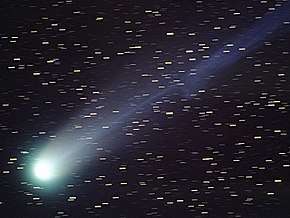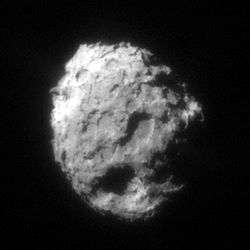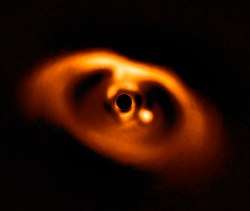Exocomet
An exocomet, or extrasolar comet, is a comet outside the Solar System, which includes rogue comets and comets that orbit stars other than the Sun. The first exocomets were detected in 1987[1][2] around Beta Pictoris, a very young A-type main-sequence star. There are now (as of February 2019) a total of 27 stars around which exocomets have been observed or suspected.[3][4][5][6][7]
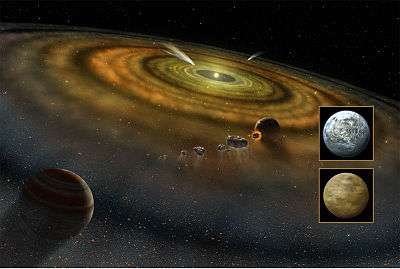
(NASA; artist's conception).
The majority of discovered exocometary systems (Beta Pictoris, HR 10,[8] 51 Ophiuchi, HR 2174,[9] 49 Ceti, 5 Vulpeculae, 2 Andromedae, HD 21620, HD 42111, HD 110411,[10][11] HD 172555,[12] HD 24966, HD 38056, HD 79469 and HD 225200[3]) are around very young A-type stars. The relative old shell star Phi Leonis shows evidence of exocomets in the spectrum[13] and comet-like activity was detected around the old F2V-type star Eta Corvi.[4] In 2018 transiting exocomets were discovered around F-type stars, using data from the Kepler space telescope.[6]
Observations of comets, and especially exocomets, improve our understanding of planet formation. Indeed, in the standard model of planet formation by accretion, planets are the result of the agglomeration of planetesimals, themselves formed by the coalescence of dust from the protoplanetary disk surrounding the star shortly after its formation. Thus, comets are the residuals of the volatile-rich planetesimals that remained in the planetary system without having been incorporated into the planets. They are considered fossil bodies that have seen the physical and chemical conditions prevailing at the time of planet formation.
Researching exocomets might provide answers to fundamental questions of the past of the solar system and the development of a life-supporting environment. Researchers can investigate the transport of water, cyanides, sulfides and pre-biotic molecules onto Earth-mass exoplanets with the help of exocomets.[14][15]
Nomenclature
The scientific term of an exocomet is Falling Evaporating Body (FEB).[6] The term Evaporating Infalling Bodies (EIBs) was first used,[16] but eventually the term FEBs was adopted from the "Falling Evaporating Bodies" model[17] or Falling Evaporating Body (FEB) scenario.[18]
Observation
The exocomets can be detected by spectroscopy as they transit their host stars. The transits of exocomets, like the transits of exoplanets, produce variations in the light received from the star. Changes are observed in the absorption lines of the stellar spectrum: the occultation of the star by the gas cloud coming from the exocomet produces additional absorption features beyond those normally seen in that star, like those observed in the ionized calcium lines. As the comet comes close enough to the star, cometary gas is evolved from the evaporation of volatile ices and dust with it. The absorption lines of a star hosting exocomets represent, beside a stable component, one or several variable redshifted components. The variable components change on short-time scales of one hour. The variable component represent the exocomets. The exocomet falls towards the star and any absorption line produced by the evaporation of the exocomet is redshifted compared to the absorption line of the star.[8]
Observations of HR 10 with the PIONIER (VLTI) and 32 years of radial velocity observations revealed that this exocomet host candidate turned out to be a binary star with each star being surrounded by a circumstellar shell. This new result can explain the variable spectral lines without exocomets. The study points out that 50% of the A-type stars could be resolved into binaries in the future and more systems with variable spectral lines attributed to exocomets could turn out to be binaries.[19]
Transiting Exocomets were first detected around KIC 3542116 and possibly KIC 11084727 by a group of citizen scientists and professional astronomers. The Kepler mission detected asymmetrical dips around KIC 3542116, a F2V-type star that are consistent with models of transiting exocomets. The dips were found by one of the authors, a Planet Hunters participant, in a visual search over 5 months of the complete Q1-Q17 Kepler light curve archive spanning 201250 target stars .[6][20] TESS did observe transits of exocomets around Beta Pictoris.[21] The shape of a dip caused by a transiting exocomet is modelled as a very specific "rounded triangular" shape and can be distinguished from most transiting exoplanets.[22][23] A transiting exocomet around HD 182952 (KIC 8027456) is the first exocomet found in an automated search for transiting exocomets.[7] Irregular dimming events around KIC 8462852[5] have been interpreted as exocomets, but the shape of the dips are different from discovered exocomet transits.[21]
During formation of the Oort Cloud through planetary perturbations, stellar encounters, and the galactic tide, a comet can be ejected and leave the solar system.[24] Binary systems are another possible source of ejected exocomets.[25] These ejected exocomets belong to the interstellar comets and can be observed directly if they enter the solar system.[26][27]
Indirect evidence of exocomets
Exocomets are suggested as one source of white dwarf pollution. After a star from the main sequence becomes a giant star, it loses mass. Planetesimals in an analog of the solar Oort Cloud can be directed toward the inner stellar system. This is a consequence of the mass-loss during the AGB stage.[28] The giant star will eventually become a white dwarf and an exocomet that gets too close to the white dwarf will sublimate or tidal disrupted by the gravity of the white dwarf. This will produce dusty debris around the white dwarf, which is measurable in infrared wavelengths.[29] The material can be accreted by the white dwarf and pollute the atmosphere. This pollution appears in the spectra of a white dwarf as metal lines.[30] In 2017 a study concluded that spectral lines in the white dwarf WD 1425+540 are attributed to an accretion of a Kuiper-Belt analog. Kuiper-Belt objects are icy bodies in the solar system that sometimes become comets.[31][32] Dusty material around the white dwarf G 29-38 also has been attributed to an exocomet.[33]
A gaseous cloud around 49 Ceti has been attributed to the collisions of comets in that planetary system.[34]
Gallery
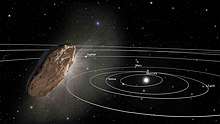
.jpg)
.jpg) Artist's impression of an exocomet falling into white dwarf WD 1425+540.[31]
Artist's impression of an exocomet falling into white dwarf WD 1425+540.[31]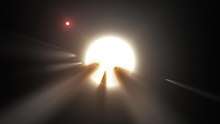 Artist's concept of a cloud of disintegrating exocomets around KIC 8462852.
Artist's concept of a cloud of disintegrating exocomets around KIC 8462852.
See also
| Wikimedia Commons has media related to Exocomets. |
- Exomoon – Any moon beyond the Solar System
- Exoplanet – Any planet beyond the Solar System
- Interstellar object – Astronomical object not gravitationally bound to a star
- Kepler space telescope – Tenth mission of the Discovery program; optical space telescope for exoplanetology
- List of stars that dim oddly – Stars that dim in an odd way
- Rogue planet – A planetary-mass object that orbits the galaxy directly
- 2I/Borisov – Interstellar comet passing through the Solar System, discovered in 2019
References
- Ferlet, R.; Vidal-Madjar, A. & Hobbs, L. M. (1987). "The Beta Pictoris circumstellar disk. V - Time variations of the CA II-K line". Astronomy and Astrophysics. 185: 267–270. Bibcode:1987A&A...185..267F.
- Beust, H.; Lagrange-Henri, A.M.; Vidal-Madjar, A.; Ferlet, R. (1990). "The Beta Pictoris circumstellar disk. X - Numerical simulations of infalling evaporating bodies". Astronomy and Astrophysics. 236: 202–216. Bibcode:1990A&A...236..202B.
- Welsh, Barry Y.; Montgomery, Sharon L. (February 2018). "Further detections of exocomet absorbing gas around Southern hemisphere A-type stars with known debris discs". MNRAS. 474 (2): 1515–1525. Bibcode:2018MNRAS.474.1515W. doi:10.1093/mnras/stx2800. ISSN 0035-8711.
- Welsh, Barry; Montgomery, Sharon L. (January 2019). "Comet-like activity in the circumstellar debris disk surrounding the 1.4 Gyr-old F2V star HD 109085". AAS. 233: 340.06. Bibcode:2019AAS...23334006W.
- Boyajian, T. S.; et al. (April 2016). "Planet Hunters IX. KIC 8462852 – where's the flux?". Monthly Notices of the Royal Astronomical Society. 457 (4): 3988–4004. arXiv:1509.03622. Bibcode:2016MNRAS.457.3988B. doi:10.1093/mnras/stw218.
- Rappaport, S.; Vanderburg, A.; Jacobs, T.; LaCourse, D.; Jenkins, J.; Kraus, A.; Rizzuto, A.; Latham, D. W.; Bieryla, A.; Lazarevic, M.; Schmitt, A. (2018-02-21). "Likely transiting exocomets detected by Kepler". Monthly Notices of the Royal Astronomical Society. 474 (2): 1453–1468. arXiv:1708.06069. Bibcode:2018MNRAS.474.1453R. doi:10.1093/mnras/stx2735. ISSN 0035-8711. PMC 5943639. PMID 29755143.
- Kennedy, Grant M.; Hope, Greg; Hodgkin, Simon T.; Wyatt, Mark C. (2019-02-01). "An automated search for transiting exocomets". Monthly Notices of the Royal Astronomical Society. 482 (4): 5587–5596. arXiv:1811.03102. Bibcode:2019MNRAS.482.5587K. doi:10.1093/mnras/sty3049. ISSN 0035-8711.
- Lagrange-Henri, A. M.; Beust, H.; Ferlet, R.; Vidal-Madjar, A. & Hobbs, L. M. (1990). "HR 10 - A new Beta Pictoris-like star?". Astronomy and Astrophysics. 227: L13–L16. Bibcode:1990A&A...227L..13L.
- Lecavelier Des Etangs, A.; et al. (1997). "HST-GHRS observations of candidate β Pictoris-like circumstellar gaseous disks". Astronomy and Astrophysics. 325: 228–236. Bibcode:1997A&A...325..228L.
- Welsh, B. Y.; Montgomery, S. (2013). "Circumstellar Gas-Disk Variability Around A-Type Stars: The Detection of Exocomets?". Publications of the Astronomical Society of the Pacific. 125 (929): 759–774. Bibcode:2013PASP..125..759W. doi:10.1086/671757.
- "'Exocomets' Common Across Milky Way Galaxy". Space.com. 7 January 2013. Archived from the original on 16 September 2014. Retrieved 8 January 2013.
- Kiefer, F.; Lecavelier Des Etangs, A.; et al. (2014). "Exocomets in the circumstellar gas disk of HD 172555". Astronomy and Astrophysics. 561: L10. arXiv:1401.1365. Bibcode:2014A&A...561L..10K. doi:10.1051/0004-6361/201323128.
- Eiroa, C.; Rebollido, I.; Montesinos, B.; Villaver, E.; Absil, O.; Henning, Th; Bayo, A.; Canovas, H.; Carmona, A.; Chen, Ch; Ertel, S. (2016-10-01). "Exocomet signatures around the A-shell star φ Leonis?". Astronomy & Astrophysics. 594: L1. arXiv:1609.04263. Bibcode:2016A&A...594L...1E. doi:10.1051/0004-6361/201629514. ISSN 0004-6361.
- Cuntz, Manfred; Loibnegger, Birgit; Dvorak, Rudolf (2018-11-30). "Exocomets in the 47 UMa System: Theoretical Simulations Including Water Transport". The Astronomical Journal. 156 (6): 290. arXiv:1811.09579. Bibcode:2018AJ....156..290C. doi:10.3847/1538-3881/aaeac7. ISSN 1538-3881.
- Matrà, Luca; Kral, Quentin; Su, Kate; Brandeker, Alexis; Dent, William; Gaspar, Andras; Kennedy, Grant; Marino, Sebastian; Öberg, Karin; Roberge, Aki; Wilner, David (2019-04-04). "Exocometary Science". Bulletin of the American Astronomical Society. 51 (3): 391. arXiv:1904.02715. Bibcode:2019BAAS...51c.391M.
- Lagrange-Henri, A. M.; Gosset, E.; Beust, H.; Ferlet, R.; Vidal-Madjar, A. (October 1992). "The beta Pictoris circumstellar disk. XIII. Survey of the variable CA II lines". Astronomy and Astrophysics. 264: 637–653. Bibcode:1992A&A...264..637L. ISSN 0004-6361.
- Beust, H. (1994). "β Pictoris: The "Falling Evaporating Bodies" Model". CDDP. 10: 35. Bibcode:1994cddp.conf...35B.
- Vidal-Madjar, A.; Lagrange-Henri, A.-M.; Feldman, P. D.; Beust, H.; Lissauer, J. J.; Deleuil, M.; Ferlet, R.; Gry, C.; Hobbs, L. M.; McGrath, M. A.; McPhate, J. B. (October 1994). "HST-GHRS observations of β Pictoris: additional evidence for infalling comets". Astronomy and Astrophysics. 290: 245–258. Bibcode:1994A&A...290..245V. ISSN 0004-6361.
- Montesinos, B.; Eiroa, C.; Lillo-Box, J.; Rebollido, I.; Djupvik, A. A.; Absil, O.; Ertel, S.; Marion, L.; Kajava, J. J. E.; Redfield, S.; Isaacson, H.; Cánovas, H.; Meeus, G.; Mendigutía, I.; Mora, A.; Rivière-Marichalar, P.; Villaver, E.; Maldonado, J.; Henning, T. (September 2019). "HR 10: A main-sequence binary with circumstellar envelopes around both components. Discovery and analysis". Astronomy & Astrophysics. 629: A19. arXiv:1907.12441. Bibcode:2019A&A...629A..19M. doi:10.1051/0004-6361/201936180. ISSN 0004-6361.
- EDT, Meghan Bartels On 10/30/17 at 2:24 PM (2017-10-30). "Astronomers have detected comets outside our solar system for the first time ever". Newsweek. Retrieved 2019-11-12.
- Zieba, S.; Zwintz, K.; Kenworthy, M. A.; Kennedy, G. M. (2019-05-01). "Transiting exocomets detected in broadband light by TESS in the β Pictoris system". Astronomy & Astrophysics. 625: L13. arXiv:1903.11071. Bibcode:2019A&A...625L..13Z. doi:10.1051/0004-6361/201935552. ISSN 0004-6361.
- Lecavelier Des Etangs, A.; Vidal-Madjar, A.; Burki, G.; Lamers, H. J. G. L. M.; Ferlet, R.; Nitschelm, C.; Sevre, F. (December 1997). "Beta Pictoris light variations. I. The planetary hypothesis". Astronomy and Astrophysics. 328: 311. Bibcode:1997A&A...328..311L. ISSN 0004-6361.
- Lecavelier Des Etangs, A.; Vidal-Madjar, A.; Ferlet, R. (21 Dec 1998). "Photometric stellar variation due to extra-solar comets". Astronomy and Astrophysics. 343: 916. arXiv:astro-ph/9812381. Bibcode:1999A&A...343..916L. ISSN 0004-6361.
- Duncan, M.; Quinn, T.; Tremaine, S. (November 1987). "The Formation and Extent of the Solar System Comet Cloud". AJ. 94: 1330. Bibcode:1987AJ.....94.1330D. doi:10.1086/114571. ISSN 0004-6256.
- Jackson, Alan P.; Tamayo, Daniel; Hammond, Noah; Ali-Dib, Mohamad; Rein, Hanno (2018-07-21). "Ejection of rocky and icy material from binary star systems: implications for the origin and composition of 1I/'Oumuamua". Monthly Notices of the Royal Astronomical Society: Letters. 478 (1): L49–L53. arXiv:1712.04435. Bibcode:2018MNRAS.478L..49J. doi:10.1093/mnrasl/sly033. ISSN 1745-3925.
- Hallatt, Tim; Wiegert, Paul (2020). "The Dynamics of Interstellar Asteroids and Comets within the Galaxy: an Assessment of Local Candidate Source Regions for 1I/'Oumuamua and 2I/Borisov". The Astronomical Journal. 159 (4): 147. arXiv:1911.02473. Bibcode:2020AJ....159..147H. doi:10.3847/1538-3881/ab7336.
- Bolin, Bryce T.; Lisse, Carey M.; Kasliwal, Mansi M.; Quimby, Robert; Tan, Hanjie; Copperwheat, Chris; Lin, Zhong-Yi; Morbidelli, Alessandro; Bauer, James; Burdge, Kevin B.; Coughlin, Michael (2019-10-30). "Characterization of the Nucleus, Morphology and Activity of Interstellar Comet 2I/Borisov by Optical and Near-Infrared GROWTH, Apache Point, IRTF, ZTF and Keck Observations". arXiv:1910.14004 [astro-ph.EP].
- Caiazzo, Ilaria; Heyl, Jeremy S. (2017-08-11). "Polluting white dwarfs with perturbed exo-comets". Monthly Notices of the Royal Astronomical Society. 469 (3): 2750–2759. arXiv:1702.07682. Bibcode:2017MNRAS.469.2750C. doi:10.1093/mnras/stx1036. ISSN 0035-8711.
- Stone, Nicholas; Metzger, Brian D.; Loeb, Abraham (2015-03-21). "Evaporation and accretion of extrasolar comets following white dwarf kicks". Monthly Notices of the Royal Astronomical Society. 448 (1): 188–206. arXiv:1404.3213. Bibcode:2015MNRAS.448..188S. doi:10.1093/mnras/stu2718. ISSN 0035-8711.
- Zuckerman, B.; Koester, D.; Reid, I. N.; Hünsch, M. (2003-09-10). "Metal Lines in DA White Dwarfs*". The Astrophysical Journal. 596 (1): 477. Bibcode:2003ApJ...596..477Z. doi:10.1086/377492. ISSN 0004-637X.
- information@eso.org. "Hubble finds big brother of Halley's Comet ripped apart by white dwarf". www.spacetelescope.org. Retrieved 2019-12-27.
- Xu (许偲艺), S.; Zuckerman, B.; Dufour, P.; Young, E. D.; Klein, B.; Jura, M. (2017-02-09). "The Chemical Composition of an Extrasolar Kuiper-Belt-Object". The Astrophysical Journal. 836 (1): L7. arXiv:1702.02868. Bibcode:2017ApJ...836L...7X. doi:10.3847/2041-8213/836/1/l7. ISSN 2041-8213.
- "NASA's Spitzer Finds Possible Comet Dust Around Dead Star". NASA/JPL. Retrieved 2019-12-27.
- Zuckerman, B.; Song, Inseok (2012). "A 40 Myr Old Gaseous Circumstellar Disk at 49 Ceti: Massive CO-Rich Comet Clouds at Young A-Type Stars". The Astrophysical Journal. 758 (2): 77. arXiv:1207.1747. Bibcode:2012ApJ...758...77Z. doi:10.1088/0004-637X/758/2/77.
- "Exocomets plunging into a young star (artist's impression)". www.spacetelescope.org. Retrieved 12 January 2017.
